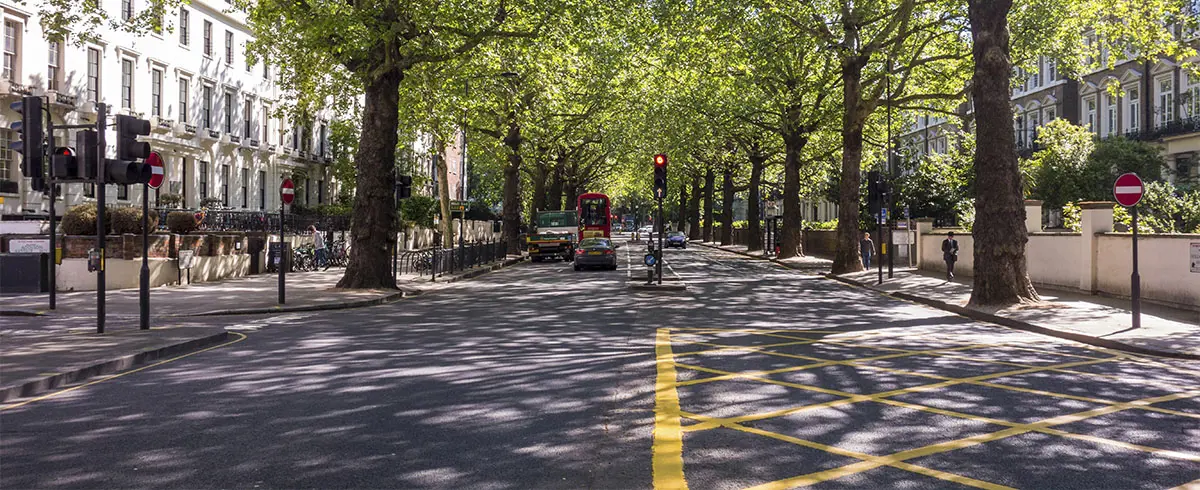In July, the UK sweltered in the hottest temperatures on record, during what the MET office referred to as a
‘historic hot spell[1].’ As mercury climbed to over 40 degrees
, much of the country buckled under the extreme heat, with significant travel disruption, wider infrastructure failures, pressure on NHS and in severe cases fires.
Following last month’s events, it is safe to say in the UK our heatwave resilience is poor. Heatwaves will only increase in frequency and intensity as climate change continues to accelerate, so the need to take decisive action to increase urban resilience is pressing. Rather than looking to hi-tech, mechanical solutions to cool our towns and cities, we need to go back to basics and look to trusted and dependable methods which have stood the test of time.
Planting trees to provide shades is a simple, often overlooked strategy for cooling. Trees and vegetation have enormous potential to help tackle extreme temperatures in a sustainable way. This blog will explore how NPPF Paragraph 131, although by default a policy focused on beauty and design, presents a golden opportunity through which to deliver sustainable cooling in new developments.
Cooling effect of soft landscaping
Trees have a natural ability to cool the surrounding air temperature by intercepting radiation before it gets to the ground. Also the process of evapotranspiration from their leaves- subsequently cools the trees down and reduces the energy available to warm the surrounding atmosphere. Large tree canopies with a larger surface area are able to provide amplified cooling effect compared to low level vegetation and planting. To increase shade and canopy coverage we should increase tree planting around footpaths and road networks.
A recent study by the BBC
[2] using satellite data has mapped how vulnerable different postcodes are across the country to extreme temperatures during spells of hot weather. A heat hazard score, ranging from 1 to 5, indicates how susceptible the postcode is to extreme heat. The study reports that up to 6 million people in the UK live in areas of higher risk to extreme temperatures. What is evident from the data is that densely built up areas scored higher compared to more rural areas or areas with a high tree canopy coverage. Wide dense tree canopies provide the greatest benefit which can be difficult to integrate and implement into existing urban fabric.
There are often challenges to implementing trees within a new development such as identifying a suitable species for the site, meeting space requirements, maintenance, and problems with insurance providers who are concerned about risk trees present to nearby building and potential damage to foundations and building fabric. However, where there is limited room for trees and vegetation, developers can look to greening roofs and walls as an alternative route.
The latest revision of the National Planning Policy Framework
[3] has a renewed focus on delivering ‘beauty’ and well-designed places through good quality design. The NPPF identifies building ‘tree lined streets’ as a way of ensuring attractive spaces and places.
Paragraph 131 notes policy and decision makers should ensure new streets are tree lined (unless there are compelling reasons this would not be appropriate). Importantly the guidance notes that this means the right trees in the right places. It also promotes other opportunities for planting to be explored such as parks and for existing trees to be retained. Although climate change is given a mention with respect to the ability of trees to adapt to climate change it is clear that trees have wider environmental attributes and ability to help mitigate the fall out of climate change including heatwaves. Tree lined streets with wide canopy coverage would deliver much greater cooling benefits in comparison to the more traditional and conventional forms of soft landscaping we see in many developments today.
Paragraph 131 has emerged from a focus on building beautiful however it should also be applied as the simple, yet powerful, policy intervention required to increase adaptability and sustainability. There should be a greater recognition and emphasis within Paragraph 131 and wider planning policy on the importance of trees and their role to play in delivering climate-responsive and reactive design.
There needs to be a shift from reactive to proactive approach to heatwaves including implementing responsive design measures to ensure that our urban environment is better equipped to deal with extreme temperatures and heatwaves. Trees are an under-utilised passive solution to deal with rising global temperatures and extreme weather. Paragraph 131 should be deployed to encourage an important shift in focus to sustainability and climate change resilience. To improve the liveability of the UK in hotter summer months we must plant more trees in our vulnerable towns and cities. Proactive town planning can lead the way on this and tap into the cooling potential of trees.
[1] Met Office, UK prepares for historic hot spell
[2] BBC News, Check your postcode: Is your area vulnerable to extreme heat?
[3] National Planning Policy Framework


